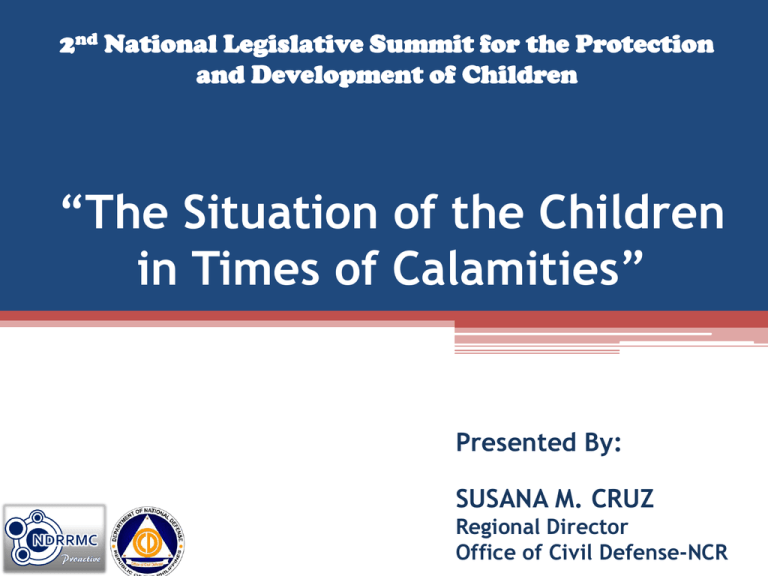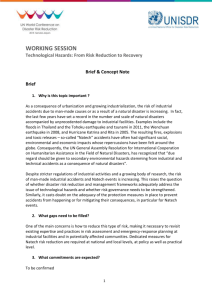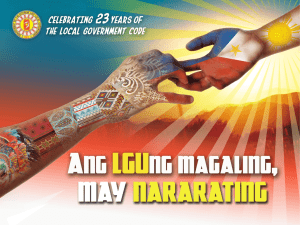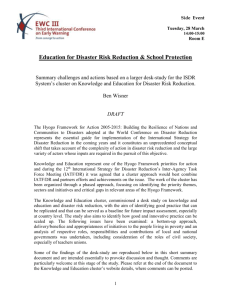the philippine disaster risk profile
advertisement

2nd National Legislative Summit for the Protection and Development of Children “The Situation of the Children in Times of Calamities” Presented By: SUSANA M. CRUZ Regional Director Office of Civil Defense-NCR Module Objectives THE PHILIPPINE DISASTER RISK PROFILE RP DISASTER RISK PROFILE RP is vulnerable to almost all types of natural hazards because of its geographical location RP DISASTER RISK PROFILE The Philippine Archipelago occupies the western ring of the Pacific Ocean (Western Segment of the Pacific Ring of Fire), a most active part of the earth that is characterized by an ocean-encircling belt of active volcanoes and earthquake generators (faults). The Philippines is located in the Pacific typhoon belt. The country experiences an average of 20 typhoons a year, 5 of which are said to be destructive. NATURAL HAZARDS FLOODS TYPHOONS AND STORM SURGES EARTHQUAKES VOLCANIC ERUPTIONS CLIMATIC VARIABILITIES (LA NIÑA/EL NIÑO) TSUNAMI LANDSLIDES GROUND SUBSIDENCE MANMADE HAZARDS FIRE INCIDENTS SEA ACCIDENTS AIR ACCIDENTS LAND ACCIDENTS OIL SPILL CIVIL STRIFE POLLUTION (SOLID WASTE, AIR, WATER AND THERMAL) INDUSTRIAL ACCIDENTS (RADIOACTIVE FALLOUT, GAS LEAKS) TERRORISM RED TIDE 9th in 2009 6th in 2010 World Risk Index Report 2011 Source: UNU IEHS (Sept 26,2011) http://ihrrblog.org/2011/09/26/2011-un-world-risk-index/ Rank 1 2 3 4 5 7 9 14 28 34 57 85 91 104 153 Country Risk (%) Vanuatu Tonga Philippines Solomon Islands Guatemala Timor-Leste Cambodia Brunei Darussalam 32.00 29.08 24.32 23.51 20.88 17.45 16.58 14.08 Indonesia Vietnam Myanmar Thailand Malaysia Lao PDR Singapore 11.69 11.21 8.54 6.86 6.69 5.80 2.85 The Philippines ranked as 3rd Reference: UNU IHES (2011) as cited by Godillano (2014) WHEN DISASTER OCCURS….ONE OF THE MOST VULNERABLES ARE THE CHILDREN D I S A S T E R EFFECTS of DISASTERS Contribute to the emotional, psychological, social and environmental stress of the children They understand less about the situation - Provide basic information to help children understand, without providing unnecessary details that may further trouble them. EFFECTS of DISASTERS Children’s emotions are most impacted when they see the reactions of their parents and the destruction of their house/properties. EFFECTS of DISASTERS Disrupts normal operation of school. School buildings and facilities are converted into temporary evacuation centers. EFFECTS of DISASTERS Evacuation/Relocation creates an exceptional and unique coping experience and challenges. Fear of having opportunities to be with their friends and other relatives. EFFECTS of DISASTERS Children are likely to get sick or injured than adult person. CURRENT INITIATIVES CURRENT INITIATIVES • Institutionalization of the Humanitarian Cluster Approach Cluster GoP Lead UN-HCT Lead Food and Non-Food Items DSWD WFP Camp Management DSWD IOM Shelter and Livelihood DSWD IFRC WASH, Health, Nutrition, & Psychosocial Services DOH UNICEF, WHO Logistics and Emergency Telecommunications OCD WFP Education DepEd UNICEF Agriculture DA FAO Early Recovery OCD UNDP TRAINING AND EDUCATION IN DRRM (RA#10121) Integration of DRR Education in School Curricula at the Secondary and Tertiary Levels, NSTP, Sanggunian Kabataan; Mandatory Training in DRR for Public Sector Employees, including formal and nonformal, vocational, indigenous learning and outof-school youth courses and programs Disaster Preparedness & Awareness Program Conduct of Nationwide Simultaneous Earthquake Drill Disaster Preparedness & Awareness Program for Children with disabilities PHILIPPINE SCHOOL FOR THE DEAF CEREMONIAL EARTHQUAKE DRILL Orientation on Disaster Preparedness and Awareness Program. - Hazards & Vulnerabilities - Evacuation Process - Safety Tips and What to do The NDRRMC mobile applications software “BATINGAW” is designed to run on smartphones, tablet computers and other mobile devices. The name “BATINGAW” is a Pilipino word for “siren or alarm”. It is downloadable and free of charge intended for the public and focuses on disaster awareness and management. The objectives are as follows: 1. Provide handy electronic resources to the public that can be utilize in times of emergencies. 2. Increase public awareness on the fundamentals of Disaster Risk Reduction and areas for informationsharing that can be incorporated in actions needed to future emergencies. 3. Use key learning points for preparedness activities such as knowledge for individuals and their respective family members before, during and after disasters. RECOMMENDATIONS PREPARE A FAMILY DISASTER PREPAREDNESS PLAN - Having a family disaster plan is important. This is a forward planning process in a state of uncertainty. - Discuss with your children about disaster. Children can cope more effectively with disaster when they understand what is happening and they know what to do to protect themselves, their family as well as friends Risk & Vulnerability Assessment Consolidate disaster risk information which includes natural hazards, vulnerabilities, and climate change risks, and maintain a local risk maps; Disseminate information and raise public awareness on different hazards,vulnerabilities and risks, early warning signs and countermeasures. Conduct Youth Summit on DRRM as part of Information, Education and Communication Campaign Encourage/Support DRRM Activities involving the Youth Sector. - Tree Planting Activities - Clean-Up Drive - Community Drills - Relief Operations Increase healthcare services in the affected areas. Ensure breast-feeding area at relocation site/evacuation area for lactating mothers Consider kid-friendly supplies in the evacuation areas. Support children play-hour, games and other recreations THANK YOU! Office of Civil Defense-National Capital Region (OCD-NCR) Telefax: 421-1918/913-2786 Email: officeofcivildefensencr@yahoo.com.ph











